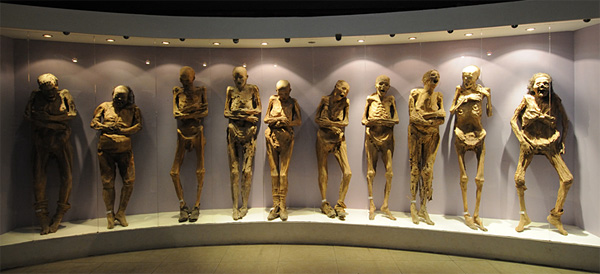
|  |  |  Entertainment | October 2009 Entertainment | October 2009  
'Accidental Mummies' Making US Debut in Detroit
 David Runk - Associated Press David Runk - Associated Press
go to original
October 09, 2009


| | They were miners, fathers, soldiers, farmers and children. They are revered by their descendants and have been visited by millions. They are rare, shocking
and completely accidental. Now, for the first time ever, they are touring the United States in an all-new touring exhibition, The Accidental Mummies of Guanajuato. |  |
Detroit Through a replica of cemetery gates, a new exhibition offers a glimpse into the lives of people whose bodies were accidentally mummified in the mining town of Guanajuato, Mexico, more than a century ago.

Thirty-six mummies on loan from Guanajuato's Museo de las Momias (Museum of the Mummies) go on public display Saturday at the Detroit Science Center as part of the "Accidental Mummies of Guanajuato" traveling exhibit.

The roughly $2 million project marks the first time the mummies have been shown in the U.S. Using scientific, historical and cultural research, the exhibit explores the lives of miners, soldiers, farmers and children whose bodies were mummified and stored in aboveground crypts.

"This is listening to these mummified remains tell their story," said Ronald Beckett, a professor emeritus at Quinnipiac University in Connecticut who studies the Guanajuato mummies and helped research the exhibit.

"Accidental Mummies" is designed to tell the story of Guanajuato, its culture and its people.

Past the exhibit gates replicating the portal at the cemetery where the first Guanajuato mummy was discovered in 1865 visitors walk through a room bordered with crypts, where they learn about Mexican traditions surrounding death. At one end, five mummies are displayed behind glass as they might have looked in their crypts.

Visitors then enter the main exhibition space, where 21 mummies some positioned as if standing upright are shown. Each mummy is accompanied by text in English and Spanish that gives his or her name, an estimate of the age at which the person died, and details about his or her life.

"Whether you worked in a mine or you were a soldier ... you had a significant place in making Guanajuato what it was at that period," said Martina Guzman, the exhibit's content developer. "All of these people were that."

According to local legend, the bodies were preserved because the city's water is rich with minerals and sulfur. But Beckett, former co-host of "The Mummy Road Show" on the National Geographic Channel, said researchers believe hot weather warmed the crypts, drying out the bodies.

Beckett and Quinnipiac colleague Jerry Conlogue have studied two-thirds of the roughly 110 mummies in the Guanajuato museum's collection. But preparations for the Detroit exhibit offered a closer look, including CT scans of seven mummies performed at a Dearborn imaging center.

With the scans, Beckett said researchers were able to learn more about medical problems of those whose bodies were mummified. Those findings were incorporated into the displays, and the scientific techniques used from DNA testing to forensic facial reconstruction are highlighted in the exhibit.

Former Mexican President Vicente Fox plans to attend a preview Friday of the exhibit, which is being produced by a Science Center subsidiary. Detroit is the first of the exhibit's seven planned U.S. stops over three years. The Science Center is in talks to finalize other stops.

"Death has been part of the culture of Mexico, and in particular of Guanajuato, for centuries," Guanajuato Mayor Eduardo Romero Hicks, who has encouraged researchers to study the mummies, said in a statement. "We want to make sure that their story is heard beyond our borders."

On the Net:
Accidental Mummies of Guanajuato exhibition: accidentalmummies.com
Detroit Science Center: detroitsciencecenter.org |

 |
|  |



